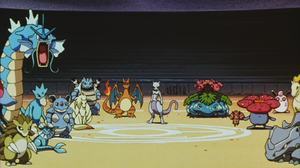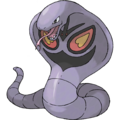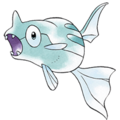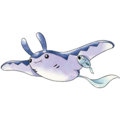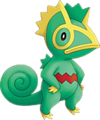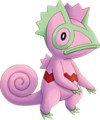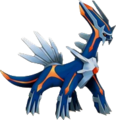Variant Pokémon
Variant Pokémon are Pokémon who vary in their appearance compared to other Pokémon of the same species. This is often due to gender, special traits and abilities, diet or environmental factors such as climate. Certain symbiotic relationships may also play a role in this.
While many variances are caused by natural processes, they sometimes can be artificially invoked as well. This may be achieved through the use of physical modifications or behavioral conditioning, or contact with certain items and radiation.
Multiple species
Form differences
- Main article: Form differences
Form differences are major variations that are officially recognised by the Pokédex.
Shiny Pokémon
- Main article: Shiny Pokémon
Shiny Pokémon are rare alternate coloration of Pokémon. These Pokémon all have a shining animation at the beginning of the battle when they are sent out, or encountered.
Shadow Pokémon
- Main article: Shadow Pokémon
Shadow Pokémon are Pokémon that have had the door to their heart shut artificially by Cipher. They are the only Pokémon capable of using Shadow moves.
Gender differences
- Main article: List of Pokémon with gender differences
From Generation IV onward, there are many Pokémon that appear differently as a result of their gender.
Of these, Unfezant, Frillish and Jellicent differ so drastically that they even have separate menu sprites and artworks.
Giant Pokémon
- Main article: Giant Pokémon
Giant Pokémon are Pokémon that are much larger than usual.
Ancient giant Pokémon
Several ancient giant Pokémon appeared in the The Ancient Puzzle of Pokémopolis. They were Gengar, Alakazam, and Jigglypuff. These Pokémon were all covered in tattoo-like marks.
Gengar emerged from a black dumbbell-like artifact, Alakazam emerged from a spoon-like artifact, and Jigglypuff emerged from an ancient bell.
Cloned Pokémon
- Main article: Cloning
Cloned Pokémon are Pokémon that have been artificially duplicated from another specimen. This process both works on living and fossilized specimens. Many of these clones are not identical to their original specimen: Mewtwo, Bulbasaurtwo, Charmandertwo, Squirtletwo, Pikachutwo, Venusaurtwo, Charizardtwo, Blastoisetwo, and Meowthtwo all display this.
Other known cloned Pokémon are Psyduck, Seadra, Tentacruel, Pidgeot, Scyther, Hitmonlee, Dewgong, Sandslash, Vaporeon, Golduck, Nidoqueen, Ninetales, Vulpix, Vileplume, Wigglytuff, Rapidash, and Rhyhorn.
- Mewtwo anime.png
Mewtwo
Mirage Pokémon
- Main article: Mirage Pokémon
Mirage Pokémon are holographic Pokémon created by Dr. Yung. They have only appeared in The Mastermind of Mirage Pokémon.
Toy Pokémon
- Main article: Toy Pokémon
Toy Pokémon are Pokémon toys given self-awareness by Wonder Keys that appear in the Pokémon Rumble series. They are different to normal Pokémon in many ways; for example, they can only know two moves at a time.
Rusty Pokémon
- Main article: Rusty Pokémon
Over time Toy Pokémon rust, causing them to become Rusty Pokémon. Dark Rust can instantaneously rust Toy Pokémon. Rusty Pokémon can be restored using Glowdrops.
Valencian Pokémon
In the episode Poké Ball Peril, a number of alternately colored Pokémon were seen on Valencia Island, including Butterfree, Raticate, Nidoran♂, Nidoran♀, Vileplume, Paras, and Weepinbell.
- OI Radicate.png
Raticate
Pink Pokémon
In the episode In The Pink, all of the Pokémon native to Pinkan Island were shown to be colored pink, due to their diet of Pinkan berries. Pink Pokémon seen on the island include Caterpie, Weedle, Pidgey, Rattata, Pikachu, Nidoran♀, Nidoran♂, Nidoking, Vileplume, Paras, Parasect, Venonat, Diglett, Mankey, Primeape, Bellsprout, Dodrio, Exeggutor, Rhyhorn and Rhydon.
Further pink Pokémon seen during Team Rocket's fantasy include Pidgeotto, Arbok, Oddish, Poliwhirl, Geodude, Weezing, Scyther and Electabuzz.
Individual species
Arbok
The Generation I Pokédex entries for Arbok state that there are six variations of markings on its belly that differ between areas. Eight designs are known, but only four have appeared in the games, and only three of which appeared in main series games. In Pokémon Adventures, Arbok gains a special ability depending on its pattern.
The most common variation has teardrop-shaped eye-like marks, a black mouth-like mark, and a black arrowhead mark with a tail extending towards Arbok's face. This design appeared in the Generation I games and all games from Pokémon FireRed and LeafGreen on, the anime, the manga (except Agatha's Arbok in Pokémon Adventures), most TCG art, the FireRed and LeafGreen Ken Sugimori art, Dream World art, and anime art. In the Pokémon Adventures manga, this is the regenerative pattern and is used by Koga's Arbok. These Arbok have a forked tongue and many fangs.
Arbok also has several variations with circular eye-like marks and a red-filled mouth-like mark with a black outline. The most common variation of this has two black fang-like marks descending onto its mouth-like mark, black eyebrow-like marks above each of its eye-like marks, and outward-pointing "eyelashes" on its eye-like marks. This design first appeared in the official Pokémon Red and Green Ken Sugimori artwork, and has also appeared in the Ruby, Sapphire, and Emerald sprites, the TCG cards Arbok from Fossil, Arbok from Expedition, and Janine's Arbok from the VS set. These Arbok have a pointed tongue and four fangs.
Another variation with the circular eye-like marks appeared in Gold, Silver, and Crystal. It has no fang-like marks on its mouth-like mark, no eyebrow-like marks, and its "eyelashes" on its eye-like marks point up. It has also appeared in Pokémon Pinball and on the Arbok Coin in Pokémon Card GB2: Here Comes Team GR!. These Arbok have a forked tongue and four fangs.
The final circular eye-like mark variation appeared solely in Pokémon Ranger. This design has no "eyelashes" on the eye-like marks and no fang-like marks on the mouth-like mark. It has three lines intersecting in the middle of the chest; two of these lines continue above each eye-like mark, while one connects from the middle to the mouth-like mark. At the end of the two upper lines are wide ends with semicircles removed from the ends. In the gaps created here is a small black dot on either side. These Arbok have four fangs.
Arbok's conceptual art had three other designs, but these were only used in the Pokémon Adventures manga, in which Agatha's Arbok's markings can be changed, altering its powers. These are the speed pattern, attack pattern, and invulnerability pattern.
A pattern with evil appearance was created by Mitsuhiro Arita solely for the TCG. It has two red eye-like marks with black marks in the middle and a combined yellow border. Its mouth-like mark represents a grin with eleven pointed teeth in red. It is featured in the card Dark Arbok from the Team Rocket set.
- Spr 2c 024.gif
Secondary circular pattern
Pikachu
- Main article: Pikachu variants
Almost every Pokémon medium has featured a different Pikachu variant, most notably Surfing and Flying Pikachu.
Shellder
Shellder can be either a bivalve shell or a spiral-shaped shell, depending on whether or not it is attached to a Slowpoke. Though impossible in the games, multiple Pokédex entries state that a Shellder can be detached from the Slowbro (making it devolve into a Slowpoke) or Slowking (making it lose its memory) it is attached to. This gives them a few more characteristics of Shellder variants than actual evolutions. However, because the Shellder is attached to and evolves with the Slowpoke, after evolution they are treated as one Pokémon. Slowbro's conceptual art depicted other variations, but they were never seen anywhere else.
Exeggcute and Exeggutor
Exeggcute are not always seen as a group of six, as well as the number of heads an Exeggutor has varies. Exeggutor's Pokédex entries state that, living in a good environment, more heads will grow in addition to the three it is usually seen with. Eventually, one of the heads will fall off and become a sole Exeggcute. This Exeggcute will telepathically comunicate with others, in order to join and form a cluster of six. Until they are gathered, Exeggcute won't be able to maintain balance.
Kangaskhan
Kangaskhan's species in Japanese is "Parent and Child Pokémon" implying it consists of two beings. This is ratified by the fact that they are all born with a child in their pouch. The child is purple, and has not yet developed most of the features from its parent, having to stay in the pouch for 3 years. Although Kangaskhan's moves are performed by the parent, some cards of the TCG have attacks that involve or are performed by the child.
Ditto
Ditto is known for its ability to transform into an exact replica of any other Pokémon. However, one of Duplica's Ditto was incapable of changing its face, with the result being a deformed replica of the target Pokémon with a blank, beady-eyed expression. This same appearance was present in Ditto cards from the EX Delta Species expansion of the TCG, as well as in a kind of Clefairy that appears in the Veilstone Game Corner.
Porygon
Porygon is able to change its color, shape and type to match its target with Conversion. It is also capable of changing its shape by using Sharpen.
Snorlax
In Snorlax Snowman, several ice-blue Snorlax adapted to more frigid climates appeared.
Remoraid
The Generation II artwork of Mantine depicted another species attached to its broad fins, stated to be a Remoraid by the Pokédex. However, this Remoraid has undeveloped fins and no teeth.
Spinda
Like Unown, Spinda has many visual variations in its species, all involving the placement of its spots. Like Unown's letter, the spot placement is generated based on the individual's personality value, and likewise, has no effect on the Pokémon's stats. Unlike Unown, however, these differences are rarely repeated, as the calculation uses the entirety of the personality value—a number that can range from zero to 4,294,967,295 (232 - 1).
Kecleon
A purple Kecleon is one of the two Kecleon Brothers in the Pokémon Mystery Dungeon series. He also appeared in the special episodes Pokémon Mystery Dungeon: Team Go-Getters out of the Gate! and Pokémon Mystery Dungeon: Explorers of Time & Darkness.
In The Kecleon Caper, a purple Kecleon nicknamed Reddy appeared under the ownership of Madison.
Mantyke
Mantyke's Pokédex entry in Pearl says that the special patterns on its back vary from region to region. While there is no difference between Sinnoh and Johto games, the Unova games have the "eyes" on its back slightly farther apart.
Arceus
Arceus has seventeen different type variatons, which correspend to the seventeen different types.
Arceus's transformation between these forms is brought about by its held item: if it is holding a Plate, it draws its type from that Plate as stated in Sinnoh's mythology, while remaining Normal-type when not holding a Plate.
In the Generation IV games, there is dummy data and a sprite programmed for a ???-type Arceus, but it cannot be obtained as there is no ???-type Plate. This data no longer exists in Generation V due to the removal of the ??? type.
While its base stats remain constant despite its changing type, its Pokéathlon performance changes slightly. Additionally, it can learn Draco Meteor only while holding the Draco Plate.
Normal 
|
Fire 
|
Water 
|
Electric 
|
Grass 
|
Ice 
|
Fighting 
|
Poison 
|
Ground 
|
Flying 
|
Psychic 
|
Bug 
|
Rock 
|
Ghost 
|
Dragon 
|
Dark 
|
Steel 
|
??? 
|
Genesect
In the games, the Drive on Genesect's back is visibly depicted on its sprite depending on which Drive it holds. However, this does not change Genesect's type, but rather the type of the move Techno Blast. If it lacks a Drive, it will be Normal-type and show a dark yellow Drive connected to it. The four Drives that can be equipped are the Shock, Burn, Chill, and Douse Drive, which make Techno Blast Electric, Fire, Ice, and Water-type, respectively. Otherwise, the change is purely cosmetic.
Normal Bug Steel |
Shock Drive Bug Steel |
Burn Drive Bug Steel |
Chill Drive Bug Steel |
Douse Drive Bug Steel |
Unseen variants
Some variants have only been mentioned in Pokédex entries; Pokémon of these variants have not been shown in any Pokémon media.
- In Vulpix's Pokédex entries, it is said to be born with a single, white-colored tail. It splits into six tails as it grows, and eventually splits from their tips to increase in number even more.
- The Diamond, Pearl, and Platinum Pokédex entries for Weezing state that triplets have been discovered. A third section of Weezing (without a face) appears on every Weezing seen so far.
Individual Pokémon
Pink Butterfree
- Main article: Pink Butterfree
A pink Butterfree appeared in Bye-Bye Butterfree. She paired up with Ash's Butterfree, who then left his Trainer to go with her.
Crystal Onix
- Main article: Crystal Onix
Crystal Onix is a special individual Onix that lives on Sunburst Island. Its body is made out of glass crystal. Due to being made out of crystal, it is no longer weak to Water-type attacks and instead weak to Fire-type attacks.
Gold Sudowoodo
In All That Glitters is Not Golden!, a Trainer named Keenan owned a Sudowoodo that he had turned to gold during a science experiment, in an attempt to make Sudowoodo immune to Water-type attacks. The changes made to Sudowoodo were eventually reversed.
Shadow Lugia
- Main article: Shadow Lugia
XD001 was a Shadow Lugia that was so thoroughly corrupted that its appearance changed.
Fake Groudon
- Main article: Groudon (M06)
In Jirachi: Wish Maker, Butler created a fake and pure evil Groudon using the power of his machine and Jirachi. This fake Groudon absorbed all life in Forina, until it was defeated by Jirachi.
Green-crystal Deoxys
- Main article: Deoxys (M07)
One of the Deoxys that appeared in Destiny Deoxys had a green crystal instead of a purple one. It also had a green mark on its face instead of a purple one.
- Deoxys Defense Forme movie 7.png
Green-crystal Defense Forme Deoxys
Primal Dialga
- Main article: Primal Dialga
In Pokémon Mystery Dungeon Explorers of Time, Explorers of Darkness, and Explorers of Sky, Dialga became Primal Dialga when it lost control of time due to the collapse of the Temporal Tower. Dialga can regain control of time and revert to its normal self if all the Time Gears are brought to the tower. As Primal Dialga, it is incapable of logical reasoning or showing mercy, only seeking self-preservation and preventing time from flowing properly.
- Dialga PMD.png
Dialga
Combined Pokémon
Venustoise
In The Ghost of Maiden's Peak, a Gastly, who had the ability to create illusions that were tangible enough to attack people, created a fusion of Venusaur and Blastoise to scare Bulbasaur and Squirtle, calling it a "Venustoise".
Zapmolcuno
- Main article: Zapmolcuno
A combination of Articuno, Zapdos and Moltres made by Team Rocket in the Pokémon Adventures manga. The legendary birds were later freed.
- Zapmolcuno Premiere.png
Zapmolcuno
Mismagius and Rayquaza
In Malice in Wonderland!, a real Mismagius merged with a Rayquaza illusion it created, giving Rayquaza the color palette and some features of Mismagius. It then attacked Ash and his friends.
- Magquaza.png
Mismagius and Rayquaza fusion
- Rayquaza movie 7.png
Rayquaza
Tao trio
Kyurem's alternate formes are a result of its fusion with with Reshiram to form White Kyurem, or with Zekrom to form Black Kyurem.

